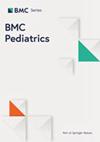"支气管炎急性呼吸衰竭患儿的高流量鼻插管 (HFNC) 治疗与无创通气 (NIV) 比较:随机对照试验"
IF 2
3区 医学
Q2 PEDIATRICS
引用次数: 0
摘要
本研究的目的是比较 HFNC疗法和无创通气(NIV/BiPAP)对出现呼吸衰竭的支气管炎患儿的治疗效果。我们假设 HFNC 治疗效果不会比 NIV 差。这是一项在巴西一家三级医院进行的非劣效性开放标签随机单中心临床试验。2岁以下无慢性疾病的儿童因支气管炎发展为轻度至中度呼吸困难(Wood-Downes-Férres评分<8分)入院,通过密封信封随机分配到HFNC组或NIV(BiPAP)组。在治疗开始后的 96 小时内记录生命体征、FiO2、Wood-Downes-Férres 评分和 HFNC/NIV 参数。对接受初始治疗后仍出现呼吸衰竭的患儿进行插管治疗。不允许交叉治疗。分析的主要结果是有创机械通气需求。次要结果是镇静剂使用率、有创机械通气持续时间、PICU LOS、住院时间和死亡率。共有 126 名患者被分配到 NIV 组(132 名随机分配,6 名排除在外),126 名患者被分配到 HFNC 组(136 名随机分配,10 名排除在外)。NIV 组的中位年龄为 2.5(1-6)个月,HFNC 组为 3(2-7)个月(P = 0.07)。RSV 是两组患者中最常见的分离病毒(NIV 和 HFNC 分别为 72% 和 71.4%)。NIV 组有 37 名患者插管,HFNC 组有 29 名患者插管(29% 对 23%,p = 0.25)。根据 Farrington-Manning 检验,在 15%的非劣效边距下,HFNC 治疗的差异为 6.3%(95% 置信区间:-4.5 至 17.1%,P < 0.0001)。在 PICU LOS 或镇静持续时间方面没有明显差异。HFNC 组的镇静需求、住院时间和有创机械通气持续时间更短。对于因支气管炎导致轻度至中度呼吸窘迫并发展为呼吸衰竭的入院婴儿,HFNC疗法并不比NIV疗法效果差。U1111-1262-1740;RBR-104z966s。注册日期:2023 年 1 月 3 日(回顾性注册)。ReBEC: https://ensaiosclinicos.gov.br/rg/RBR-104z966s .本文章由计算机程序翻译,如有差异,请以英文原文为准。
“Comparison between high-flow nasal cannula (HFNC) therapy and noninvasive ventilation (NIV) in children with acute respiratory failure by bronchiolitis: a randomized controlled trial”
The objective of this study was to compare HFNC therapy to noninvasive ventilation (NIV/BiPAP) in children with bronchiolitis who developed respiratory failure. We hypothesized that HFNC therapy would not be inferior to NIV. This was a noninferiority open-label randomized single-center clinical trial conducted at a tertiary Brazilian hospital. Children under 2 years of age with no chronic conditions admitted for bronchiolitis that progressed to mild to moderate respiratory distress (Wood-Downes-Férres score < 8) were randomized to either the HFNC group or NIV (BiPAP) group through sealed envelopes. Vital signs, FiO2, Wood-Downes-Férres score and HFNC/NIV parameters were recorded up to 96 h after therapy initiation. Children who developed respiratory failure despite receiving initial therapy were intubated. Crossover was not allowed. The primary outcome analyzed was invasive mechanical ventilation requirement. The secondary outcomes were sedation usage, invasive mechanical ventilation duration, the PICU LOS, the hospital LOS, and mortality rate. A total of 126 patients were allocated to the NIV group (132 randomized and 6 excluded), and 126 were allocated to the HFNC group (136 randomized and 10 excluded). The median age was 2.5 (1–6) months in the NIV group and 3 (2–7) months in the HFNC group (p = 0,07). RSV was the most common virus isolated in both groups (72% vs. 71.4%, NIV and HFNC, respectively). Thirty-seven patients were intubated in the NIV group and 29 were intubated in the HFNC group (29% vs. 23%, p = 0.25). According to the Farrington-Manning test, with a noninferiority margin of 15%, the difference was 6.3% in favor of HFNC therapy (95% confidence interval: -4.5 to 17.1%, p < 0.0001). There was no significant difference in the PICU LOS or sedation duration. Sedation requirement, hospital LOS and invasive mechanical ventilation duration were lower in the HFNC group. HFNC therapy is noninferior to NIV in infants admitted with mild to moderate respiratory distress caused by bronchiolitis that progresses to respiratory failure. U1111-1262-1740; RBR-104z966s. Registered 03/01/2023 (retrospectively registered). ReBEC: https://ensaiosclinicos.gov.br/rg/RBR-104z966s .
求助全文
通过发布文献求助,成功后即可免费获取论文全文。
去求助
来源期刊

BMC Pediatrics
PEDIATRICS-
CiteScore
3.70
自引率
4.20%
发文量
683
审稿时长
3-8 weeks
期刊介绍:
BMC Pediatrics is an open access journal publishing peer-reviewed research articles in all aspects of health care in neonates, children and adolescents, as well as related molecular genetics, pathophysiology, and epidemiology.
 求助内容:
求助内容: 应助结果提醒方式:
应助结果提醒方式:


